BY LINCOLN ANDERSON | Chinatown residents are up in arms about yet another homeless facility planned for their neighborhood. The city, for its part, argues the facility is needed because there are documented street homeless in the area that it would serve.
Meanwhile, Housing Works, the group that would run the site, says its program would benefit the community by shifting unwanted behavior — like heroin users shooting up — from outdoors to indoors. The facility would operate on the harm-reduction model, meaning people could freely possess and use drugs inside.
The issues around the planned homeless site, at 231 Grand St., came to a head last month at a meeting of the Community Board 2 Human Services Committee, at which the scheme was first presented.
The planned location is just a block away from Sara D. Roosevelt Park — and a block and a half away from where Christina Yuna Lee, 35, was brutally slain a month ago by a homeless man who stabbed her more than 40 times inside her own apartment.
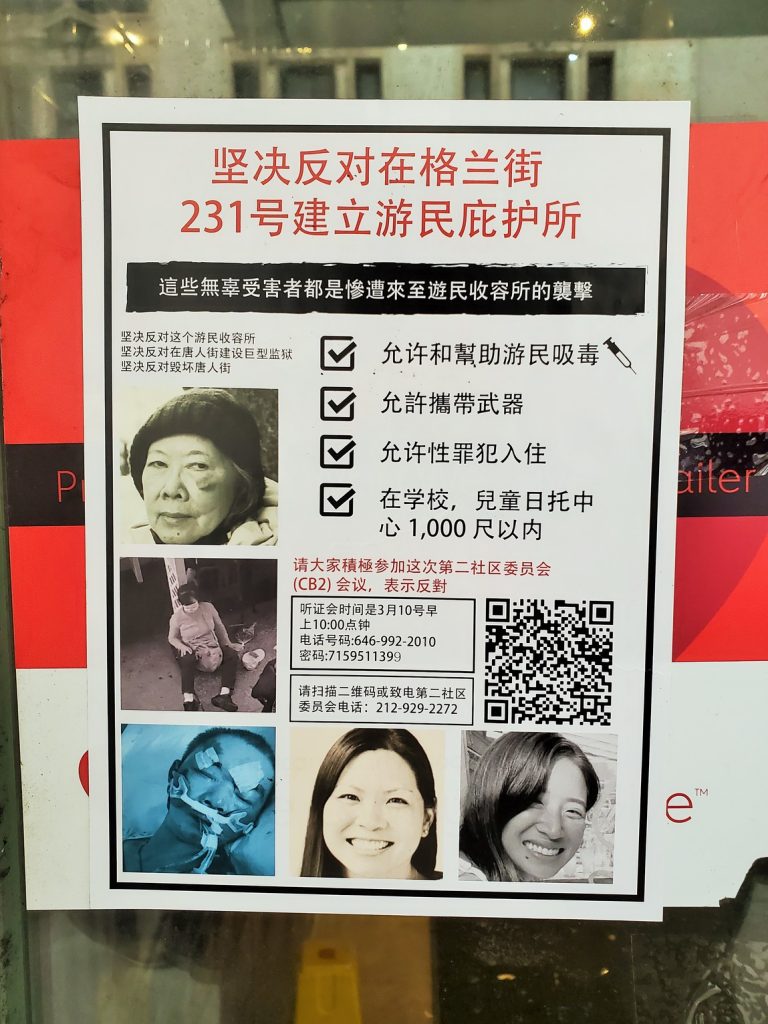
The idea is for a 24/7, co-ed facility that would include a drop-in center for up to 50 persons, plus 94 stabilization beds in individual rooms. Couples would be allowed to share a room. The goal would be for individuals in the stabilization beds to be placed in permanent housing within 12 months.
Housing Works plans to acquire the existing hotel at the location. The plan was set in motion under former Mayor de Blasio.
Like Paul’s Place, a homeless drop-in site with 24 stabilization beds slated to open soon on W. 14th Street between Sixth and Seventh Avenues, the place on Grand Street would offer showers, meals, laundry machines, psychotherapy, case management and crisis intervention. Both facilities are meant to cater expressly to street homeless persons who have resisted efforts to bring them inside.
Unlike Paul’s Place, the Grand Street building already is configured as a hotel, so a lengthy gut renovation isn’t needed. It could be operating as soon as May or June.
However, Chinatown residents currently are at the breaking point, crying that they already have six other homeless facilities in the area, with this being one of four new ones slated for the neighborhood. This oversaturation with shelters, they argue, violates the principle of “fair share” even further than it is already being violated currently.
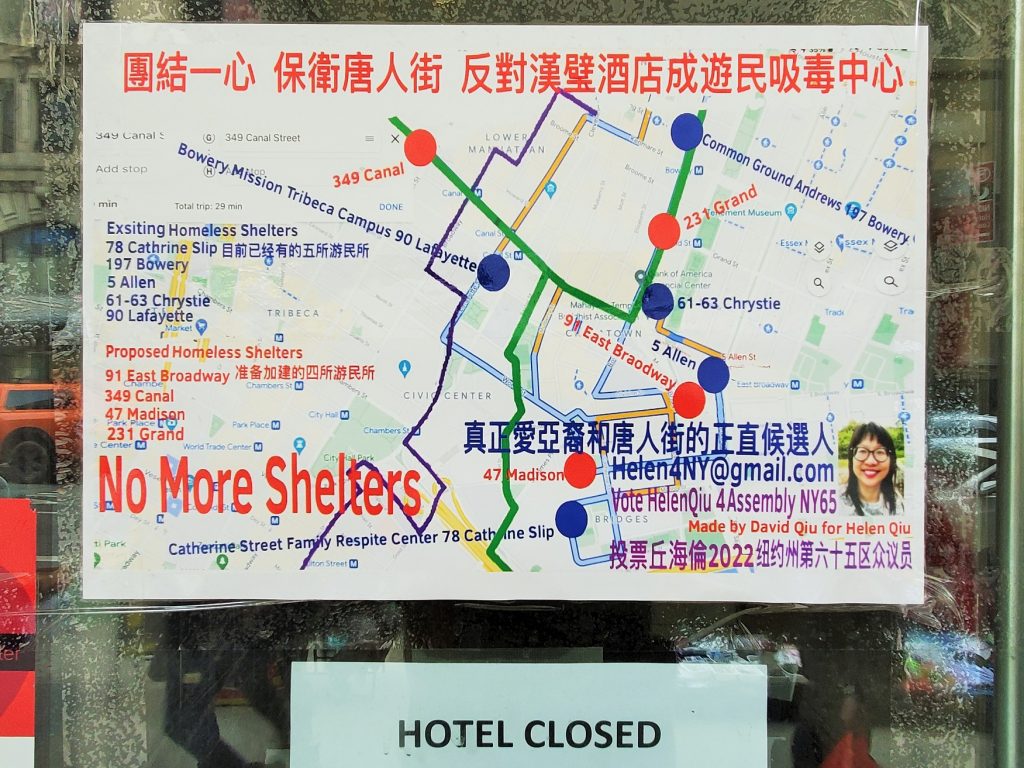
According to the Greater Chinatown Civic Coalition (gccc-nyc.org), the six existing shelters include five in Community Board 3, 227 Bowery (the Bowery Mission), 197 Bowery, 61-63 Chrystie St., 5 Allen St. and 78 Catherine Slip, plus one in C.B. 1, 90 Lafayette St., while the new, incoming shelters include two in C.B. 3, 91 East Broadway and 47 Madison St., and two in C.B. 2, 349 Canal St. and the aforementioned 231 Grand St., which the coalition characterizes as a shelter and “drug injection site.”
The February community board meeting featured one of the most active and explosive chat sidebars seen by C.B. 2 during the pandemic Zoom meetings era. Throughout the meeting, an array of project opponents posted a flurry of about 10 to 15 outraged comments per minute. One accusation was that the C.B. 2 committee and agency officials were not representative of Chinatown.
“14 people in this gallery [view] — racial makeup does not reflect the Chinatown neighborhood,” Lisa Eng posted disapprovingly of the faces she saw on the screen.
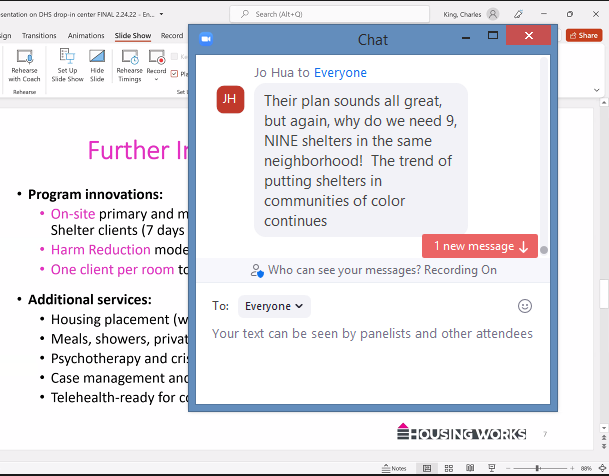
Erin Drinkwater, a deputy commissioner at the city’s Department of Social Services, said the facility — with its drop-in shelter and single-room stabilization beds — is meant to target homeless people who are resistant to coming indoors.
“This model is very important for people who are experiencing homelessness on the street,” she said. “Folks on the street are often distrustful of coming into a congregate shelter.”
Similarly, she said, the drop-in site would have “a lighter-touch engagement” with the homeless.
“Why in this neighborhood?” Jeanie Gong demanded in the chat. “This will only endanger the residents in the area. We already got a sample of the ‘clients’ that were staying there during the pandemic: Mayhem and chaos.”
“They want to destroy Chinatown,” another said. “Then the developers come in and buy on the cheap.”
Known as the Bowery Hanbee Hotel, the eight-story building sits on the southwest corner of the intersection of Bowery and Grand Street. As Gong and others pointed out, the building was used as a “COVID hotel” for homeless people this past summer during the pandemic as the city sought to depopulate its congregate shelters for health reasons.

Drinkwater said the city is siting the new homeless shelter at 231 Grand St. because there are a documented number of street homeless people living in the area that it would presumably serve.
“There are 150 on the case list in Community Board 3,” she said of the unsheltered homeless, she noted.
C.E.O. Charles King was a founder of the 32-year-old Housing Works. A Baptist minister with a law degree who, as he put it, is “living with H.I.V.,” he became an AIDS activist in the 1980s. Housing Works was the first provider in America to house people “without regard of if they were alcoholics or drug users,” he noted. Today, Housing Works houses and offers services to more than 15,000 “low-income and marginalized New Yorkers,” he explained, adding that a large percentage of them are “on drugs, booze, ex-convicts and have mental health issues.”
Despite the challenges of dealing with that population, he said, “I think most people would say that we are an asset to the community.”
“This is a very, very low threshold center,” he explained of the plan for 231 Grand St. “It’s harm reduction. We don’t search people for drugs and alcohol.”
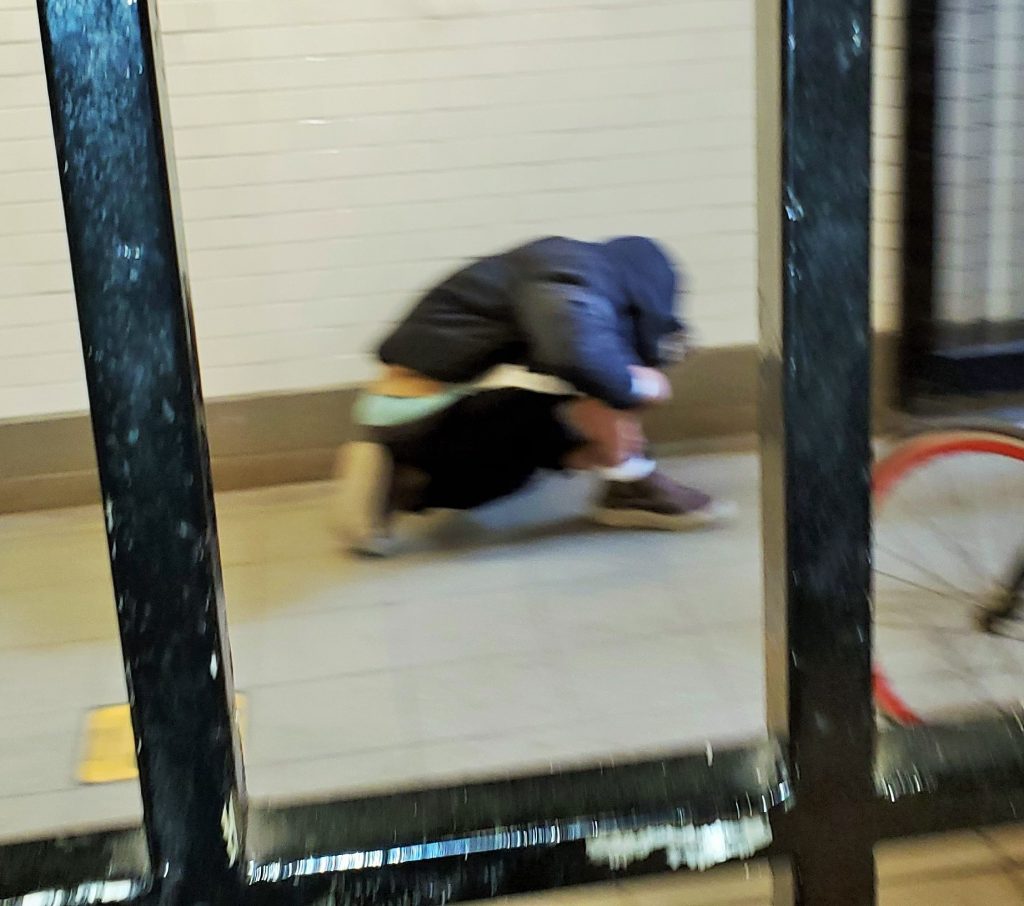
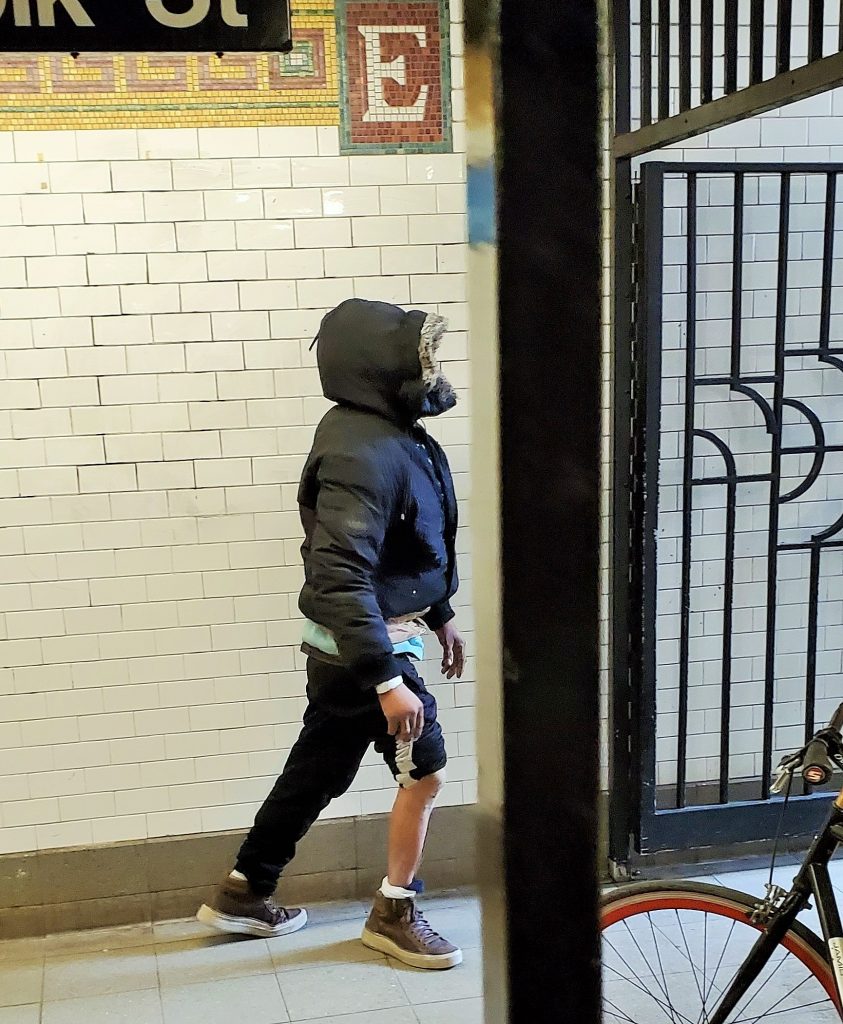
In short, he said, Housing Works feels it’s safer all around for people to do drugs and drink in the shelter than on the street, and that this is something the community would appreciate as well.
“Sounds like an open bar,” someone scoffed in the chat.
“I’m well aware of recent violent incidents that have occurred in the subway and Chinatown,” King acknowledged. “What we’re talking about is homeless people who are disconnected from care.”
King said that although Christina Yuna Lee’s alleged killer, Assamad Nash, was living in the Bowery Mission, he was “disconnected from care. Our goal is to connect people with care.”
“What about weapons?” Susanna Aaron, the chairperson of the C.B. 2 Human Services Committee, asked him.
“We find searches to be a deterrent” to getting people to come in for help, King said, noting, “Homeless people on the street often carry a lot of baggage with them. One person’s weapon is another person’s utility tool.”
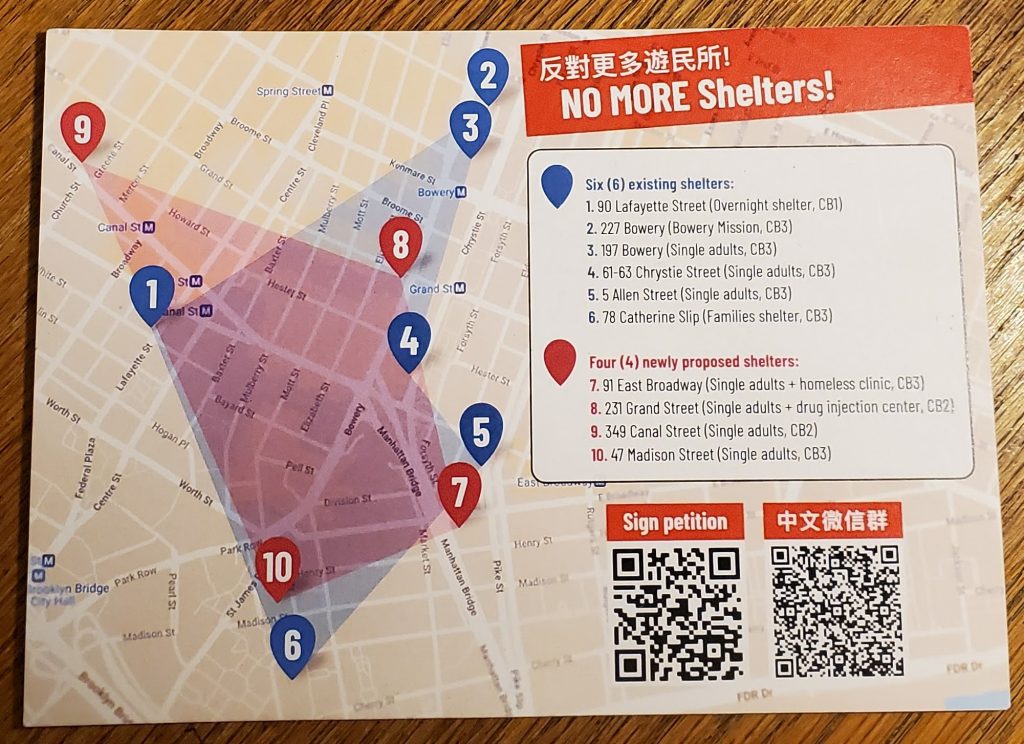
Aaron asked how they would keep 231 Grand St. from “being turned into a drug-den situation.” King responded that they’re “good at patrolling” and that this kind of facility has been “a successful model.”
“If you live in a building with 10 or more apartments, you have neighbors that are using substances,” he pointed out.
Residents, however, said the new facility would be a magnet attracting troubled individuals to the neighborhood.
King countered that he highly doubted the shelter would draw people from across Manhattan but would instead serve homeless people living right in the vicinity, such as around Sara D. Roosevelt Park or in the subway.
In a follow-up interview with The Village Sun, King said half of the people in the facility’s stabilization beds would come from outreach in the local community and the other half from outreach in Manhattan and its subway system, the latter for which the Bowery Residents’ Committee has the contract.
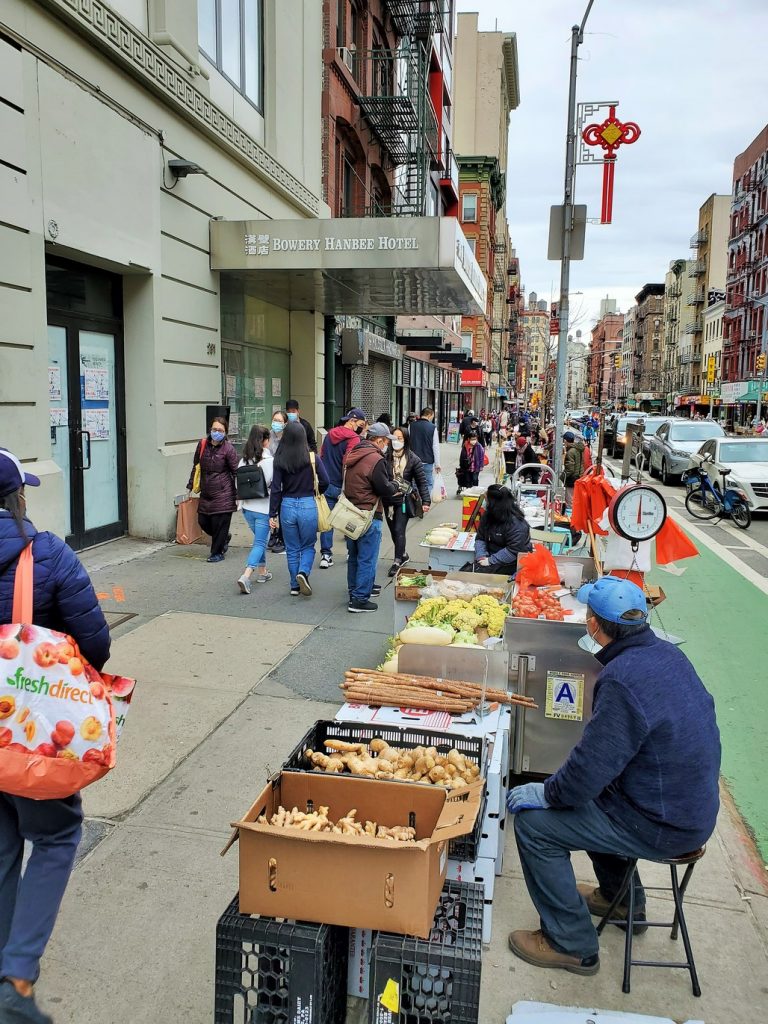
Security, he told the meeting, would be a mix of “contracted security, Department of Homeless Services, peace officers and closed-circuit cameras.”
King said he also welcomes the creation of a community advisory board for the 231 Grand St. homeless shelter.
However, residents in the chat during the meeting said that when the address was used as a COVID hotel it was a quality-of-life disaster. One of them cited “trash, people following people, cursing, urinating and defecating [on the street].” One person said a nearby bank ATM became too sketchy to use. They fear a repeat of those problems.
Opponents noted that P.S. 130, two daycare centers and a Head Start are all near the location. One resident protested that his 82-year-old father couldn’t exercise in S.D.R. Park during the pandemic “because he felt he was harassed by shelter residents.” Another said the elderly vendors who sell mushrooms, ginger and daikon along the curb in front of the hotel would no longer be safe.
“Yea, we need the Triads to fight back,” someone posted in the chat, referring to Chinese organized crime syndicates. “Or bring back community protection patrols, such as Ghost Shadows, BTK or Flying Dragons.”
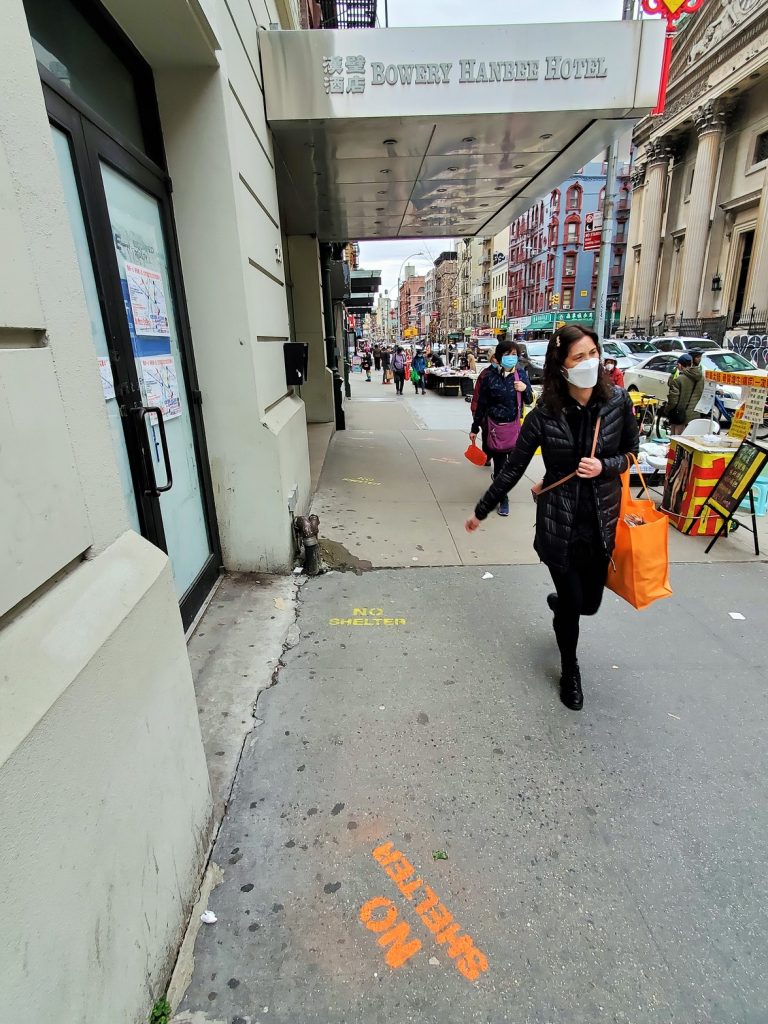
However, King offered the example of a Housing Works site at Ninth Street and Avenue D that has 32 apartments, which also sees “hundreds of day visits. You won’t find people hanging out on the streets or drug dealers [there],” he noted.
“I appreciate people’s concerns that they can’t take their children to the park because of syringes on the ground,” the Housing Works C.E.O. empathized. “That is exactly what this facility is for. … Get them into the facility and out of the park.”
Similar to Paul’s Place, the 231 Grand St. drop-in center would have lounge chairs that people could sleep in overnight if they wanted to. But, unlike Paul’s Place, in addition to outreach to fill the stabilization beds, walk-ins could also get them.
Ian Wang, Councilmember Christopher Marte’s legislative director, was on the Zoom but basically listened to what was being said.
“This is the first presentation,” he noted. “We are collecting information, like everyone else.”
Marte later told The Village Sun he was on the Zoom call, too, but was also busy dealing that night with a water main break that had knocked out water to Confucius Plaza. He said he would write a letter to the administration about the shelter that would pose the question, “Why don’t they do the Fair Share analysis before they choose the site?”
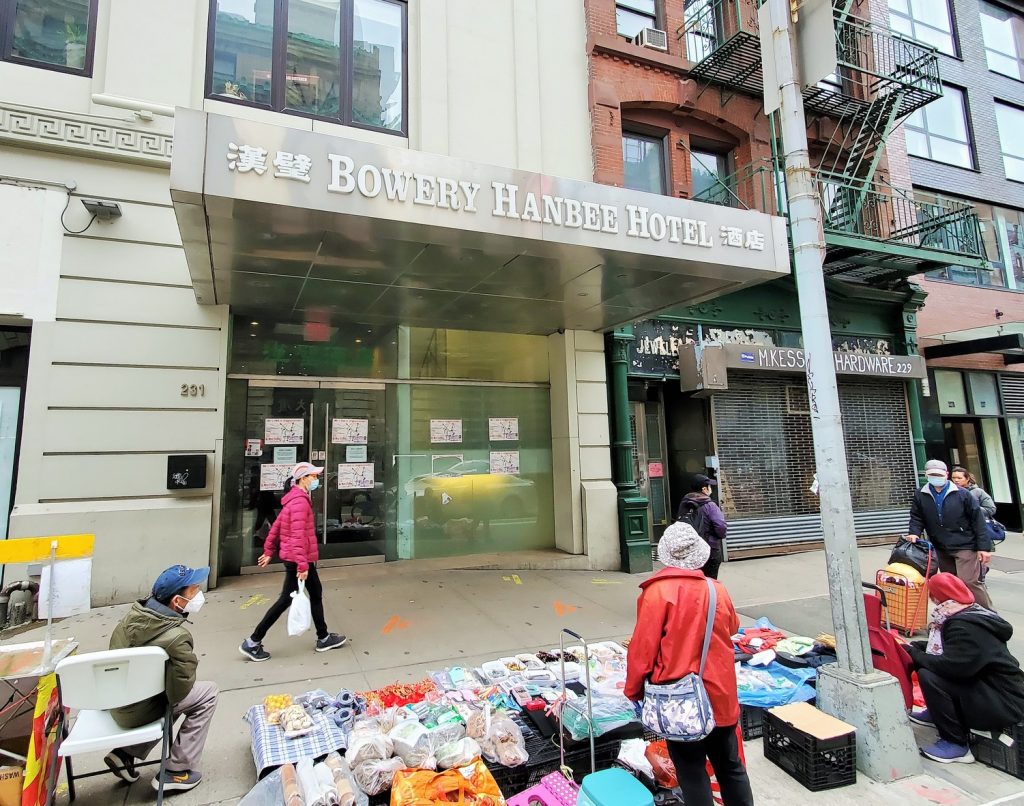
Basically, as others point out, Marte said that while the homeless shelters may be spread out between several community boards, within those boards, many of them are concentrated in Chinatown.
“Chinatown has three community boards,” Marte said. “But there’s a cluster [of shelters] in this area. They’re not looking at Chinatown as one community.”
Technically, as C.B. 2’s Aaron noted, the community board “has no role” in approving the homeless shelter since it doesn’t fall under the city’s ULURP land-use review process.
“They don’t need us to approve it,” she said.
In addition to all of their fired-up comments in the chat, residents were also allowed to testify later on in the meeting. One of them said the number of homeless in the area has grown alarmingly.
“In the space of two or three years, the population has exploded very quickly,” she said, adding there has been no explanation as to why from the city or state.
However, Drinkwater of D.S.S. chalked it up to “the pandemic and lots of destabilization.” But locals said that methadone clinics and other facilities were what was drawing homeless to the area.
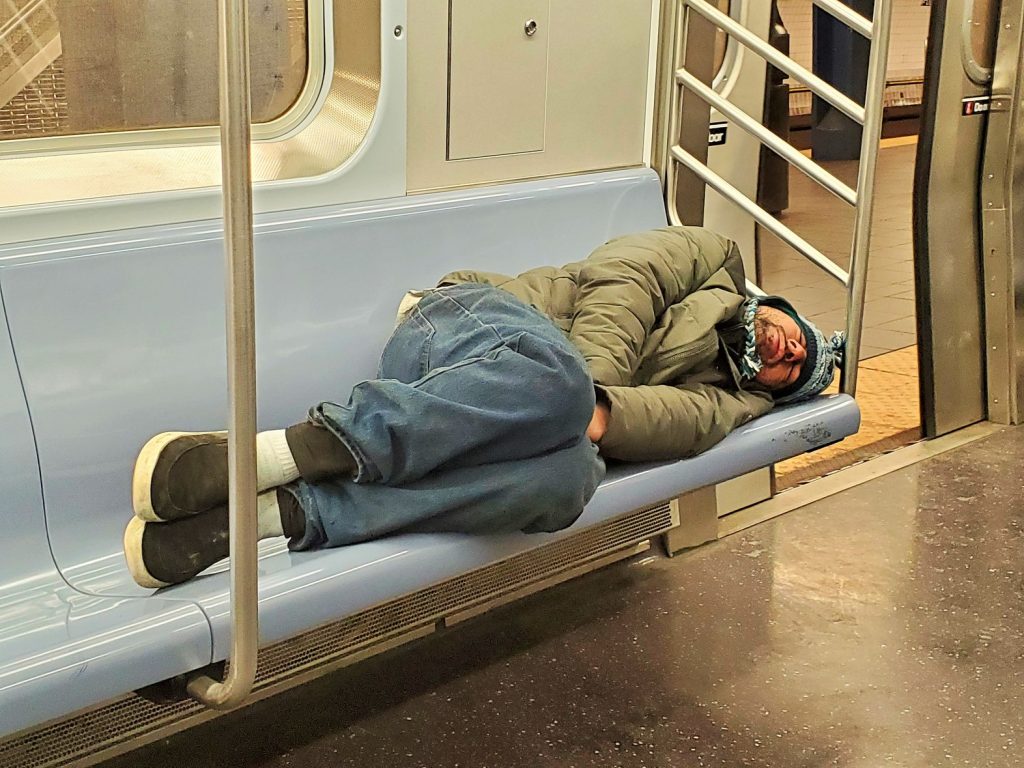
Helen Qiu, a Christian pastor and candidate for Assembly in Lower Manhattan’s 65th District, blasted the idea that the shelter is already a fait accompli.
“This is not communication,” she said of the presentation. “This is an announcement. … We cannot have 10 shelters. The real issue is our community cannot take anymore homeless shelters.”
In a follow-up interview with The Village Sun, King reiterated that the combination homeless shelter and drop-in site ultimately would help, not hurt the community, by serving those who need it.
“If you’ve ever strolled Sara D. Roosevelt Park, you would see it full of homeless people, as well as people using injection drugs,” he said. “That would be a prime target group.”
As for complaints that Chinatown is already oversaturated with homeless shelters, King said, “I think the community needs to take that up with the Mayor’s Office.”
However, he added, “I certainly agree — I don’t see a lot of shelters being opened up on the Upper East Side.”
Reiterating the benefit of the harm-reduction model, he said, “So what I’m doing is depopulating the park of homeless, so that people, kids can use the park. If you have a nice, cozy room of your own, are you going into the park? You don’t have to be nodding off in the park. Try, come to the facility, inject in a bathroom, sit in a lounge chair, get comfortable…enjoy your ride.”

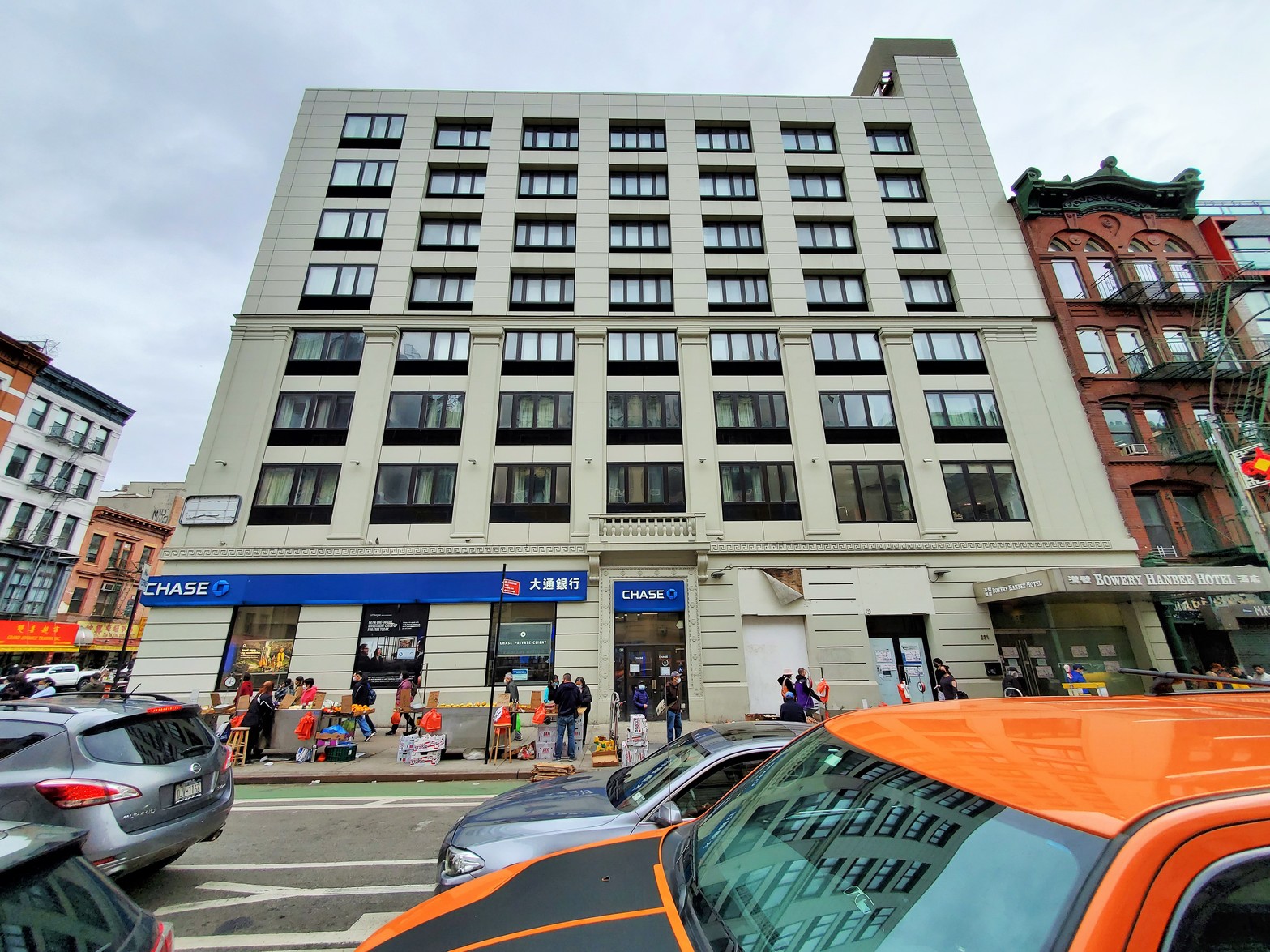
Add immaturity to your cowardice. You can’t answer questions, so you have to resort to what only you consider a clever comeback. Apparently you can’t even acknowledge that homeless shelter contractors in NYC make millions. But, then again, it’s better to take refuge in “irony” than admit you are just another smug, virtue-signaling coward. I’m done with this conversation since you apparently won’t answer honest questions.
“What is the ethnic makeup of people shooting up?” isn’t a serious question that deserves a serious answer. I’ve posted plenty of earnest responses to people who seem to be acting in better faith than you. You’re just doing anti-homeless and anti-black fearmongering.
Apparently, this fake news site censors. You can’t even comment and ask a question about the racial makeup of those committing crimes against Asians and how many Chinese are actually homeless and would benefit from these so-called shelters, in response to LES3025. I posted a long response and it went into oblivion.
Sounds like you were trying to post something racist so maybe it’s a win-win that they decided not to publish it. Although I do appreciate it when people tell on themselves.
Actually, they posted it after my second comment about them seeming to censor. Sounds like you are the racist one. I see you never answered any of my questions. Like you, I do appreciate it when people tell on themselves.
My first comment was under Villageresident, and the two comments were made a few days apart but posted at the same time. You are either a paid propagandist or another virtue-signaling, self-righteous coward who, when confronted, distracts with cries of racism. Or maybe something of both?
You got me. I’m a paid propagandist for the homeless shelter industrial complex.
LES3025: Talk about dishonest arguments. Now you are trying to say that Chinese Americans seniors can benefit from these shelters? How many Chinese seniors are in shelters today? Give us facts, please. Who beat up the Chinese homeless man? I can bet you it wasn’t by a Chinese person. And how many homeless Chinese men have assaulted or killed people? Please provide statistics. The city is disproportionately placing more shelters in Chinatown and it has nothing to do with helping the people who are homeless there. You say that there are many homeless living in Chinatown. What is their racial makeup? I go to Chinatown several times a week and I don’t see Chinese homeless, yet this is a predominately Chinese community, that has been preyed on by homeless and mentally ill who are black or white. What is the ethnic makeup of people shooting up? I don’t see Chinese people shooting up heroin or smoking crack, for the most part, when I go into Sara Roosevelt Park. Why are there so many non-Chinese homeless in the area? Did you even ask that question? Probably because if they congregated on the Upper East Side, the mayor would have his police chase them out. So they go to areas where they know they will suffer little harassment by law enforcement. You think nice rooms will entice addicts to stay indoors? So give them nice rooms on the pristine UES. The residents of the Upper West Side had to sue to shut down shelters in their area because the men in the shelters would defecate, urinate and masturbate in the streets. Crime also went up when the mayor put the homeless in the hotels there. Do you know anything about addiction? People shooting up don’t even know where they are. And when they need to get their next fix, where are they going to get their money? From whoever is close by. You say you live in Chinatown, but you are not part of the community. So, in other words, you are not Chinese and would be less of a target than some little Chinese granny. The problem I see isn’t Chinese NIMBYs, but that the Asians in this country traditionally have been meek and obedient to whatever the politicians decide, even if it’s against their own interests. And people are afraid of being called racist by simply stating that they do not want drug addicts in their neighborhood, no matter what color or race they are. To any Chinese reading this, if you are one of the Chinese who won’t wake up and vote out these officials who hate you, then suffer the consequences. Someone mentioned that the Chinese community is anti-black. I don’t see black people attacked by Chinese, do you? Is there racism? There is racism in every community, I have found over the years. I find it interesting that, years ago, I went to “all black” clubs and events and men would consider me exotic. Now I run into some black men who occasionally just curse me out. There is a problem with increasing anti-Asian hate crime, and putting more shelters in a Chinese community will only aggravate the issue. Sounds like the beginnings of a land grab to me by the mayor and the greedy realtors lining his pockets.
My at-a-glance response: The timing is nuts! You have out-of-control crime against Asians committed by homeless people and just at this moment you’re adding a new homeless shelter to this community? Let’s connect the dots!
There are no dots to connect. Homeless people are more likely to be victims of crime than perpetrators. And shelters help by getting people off the streets and getting some of them into the mental health system.
That’s nonsense. You get them off the streets for how long? Do they have to stay in the shelter? What’s to prevent them from going back out and shooting up? The answer is nothing. There is nothing that will prevent them from shooting up whenever and wherever they want.
Ok, so what happens in the spring, summer and fall when the weather is nice? Do they want to stay indoors the whole time? The answer and simple logic is no.
All this does is attract more of these types of people into the neighborhoods. It was never this bad until 2-3 years ago.
This doesn’t work.
There is a mountain of evidence that this does work. I posted a few examples earlier in these comments. If you want to ignore it you’re welcome to do that, but the rest of us don’t have to pretend that you have anything to contribute here.
Ok, I get it. Your opinion is right and anyone else that doesn’t agree is wrong.
I am Asian, live in Chinatown, within 2 blocks of the proposed site and 3 and 4 blocks away from the other two sites on Bowery and have experienced harassment firsthand multiple times.
You didn’t answer any of the questions posed and just dismissed them just as you accused me of ignoring your links. That’s a bit hypocritical.
There are countless articles and reports on why homeless people don’t want to go into a shelter. The reasons range from not feeling safe, to being treated improperly, abused, not being treated for the right things, etc. (I’m sure you know all this already.)
So the questions and reasons for opposition are: Why are there so many concentrated in Chinatown? Why can’t it be spread out? This would be the 6th in less than a 1-mile radius. The distances between the proposed site and the 2 existing ones on Bowery are literally 3 and 4 blocks away. Why are the people who propose these implementations not representative of the people actually living there?
We can agree to disagree and leave it at that. Save the insults.
I may have been overly dismissive (though I don’t think I made any insults), but I find it very sad and disappointing that people overlook the evidence supporting adding services for the homeless in favor of fear mongering.
You ended your comment with “This doesn’t work.” But there is a huge amount of evidence that it does, in fact, work. It doesn’t work for every single person, but in the aggregate it helps get people off the street and into the healthcare system. Posing questions like “do they have to stay in the shelter?” or “what happens in the spring, summer and fall when the weather is nice?” doesn’t add anything to the discussion or really warrant a response, because the answer is that it does work. Hypothesizing that some person could leave the shelter and go back in the street (which surely some will), doesn’t detract from the fact that this harm-reduction approach to housing has been shown to work better than other systems we have been using.
I am very familiar with the reluctance of homeless people to enter the shelters. But this is usually targeted at congregate shelters. I read some heart-wrenching accounts earlier today (https://twitter.com/GwynneFitz/status/1508488319390339074). The concern there, like many, was about the inability to find a single room. The shelter proposed at 231 Grand Street is not a congregate shelter (i.e. multiple people sleeping in one room). It is 94 individual rooms. It is precisely the type of shelter that people will be more inclined to go to.
As for why so many shelters in this area, a few things. First, other neighborhoods do need to do their part, and I would argue just as much in support of a shelter where there are none. But, putting that aside, the evidence also shows a need to meet people where they are. There is a homeless crisis here, in our neighborhood, and there isn’t any support for the idea that shelters draw people in. The people who are homeless on the street here are largely in that position despite the shelters, not because of them. They are the population that needs to be served, and they are more readily served with a shelter here than, say, on the Upper East Side.
As for why the people proposing solutions aren’t representative, I can only assume you mean not Chinese/from Chinatown. I live here, but I’m not part of that community, so I can’t really say. But I can say that the Chinatown community seems to be reacting no differently than most, as homeless shelters are opposed by neighbors almost everywhere they are proposed. But that’s particularly unfortunate because there is a homeless crisis in that community as well, particularly among the elderly. It wasn’t long ago that an 83-year-old homeless Chinese man was beaten to death on the street. Asian Americans in New York have the highest poverty rate among all racial groups, with 1 in 4 Asian American seniors living in poverty. These are people who would be served by this shelter as well, as my understanding is that a substantial proportion of the outreach for this shelter will be in this community. It is a myth that the majority of homeless people are mentally ill and/or drug addicted or that the shelters serve only those people.
So that’s where I’m coming from.
The NIMBYs opposed to this Housing Works project need to understand that the people it will help are already in our backyard. I encounter them every day walking in the Lower East Side and it breaks my heart.
Is there any research evidence that this particular version of “harm reduction” does any actual good?
Yes, there is a lot. Here are a few papers or explanations:
https://www.samhsa.gov/find-help/harm-reduction
https://alcoholstudies.rutgers.edu/combining-behavioral-harm-reduction-treatment-and-extended-release-naltrexone-for-people-experiencing-homelessness-and-alcohol-use-disorder-in-the-usa-a-randomized-clinical-trial/
https://www.ncbi.nlm.nih.gov/pmc/articles/PMC6964917/
https://law.yale.edu/sites/default/files/area/center/ghjp/documents/the_case_for_low-barrier_wrap_around_drop-in_centers_in_new_haven_connecticut_july_2020.pdf
https://www.ohtn.on.ca/Pages/Knowledge-Exchange/Rapid-Responses/Documents/RR07-2009-Housing-Harm-Reduction.pdf
https://nhchc.org/wp-content/uploads/2020/05/Healing-Hands-Harm-Reduction_FINAL2.pdf
Appreciate The Village Sun’s reporting, particularly as the NY Times has long dropped local/land use coverage.
Two things in particular:
1) There are at least four major things happening with massive impacts to the Chinatown community — SoHo rezoning, the new jail, luxury development (Two Bridges) and these shelters.
It is dishonest and disingenuous for the City to not acknowledge/not discuss these together.
2) There are quite a few homeless in NYC who are from out of town — not just from the tri-state area but from all over the U.S. Drug access in NYC is part of that.
Very skeptical that a program model offering unconditional drug support will work — my guess is that it will encourage use.
Chinatown hates homeless people. Chinatown hates incarcerated people. Chinatown hates anyone who is in precarious conditions and needs help. Chinatown hates anyone that is different than them. The Chinese community doesn’t want anything or anyone that has a problem around them. They just want to lock up our society problems away from them. They really don’t care about our city problems. Chinatown is very clingy and very racist. They want to live in their bubble and oppose anything that helps society in their neighborhood, like homeless or incarcerated people. They occupy the most expensive area of New York and they want to control it with their racist ways. City Councilmember Marte and other elected officials are backing up Chinatown’s racist agenda without shame. This is New York City and we must accept and allow help to all New Yorkers in need. Eradicate the racists and NYMBYs out of Lower Manhattan!
This is a bad look (so bad that I think it’s probably satire). It is indeed awful that people are mobilizing against a shelter that seems like a great model to help the homelessness crisis. And it’s particularly striking here given that this seems like a specific solution to the complaints everyone always has about SDR Park. I obviously support the shelter.
But the opposition is not a unique Chinatown problem and the rest of this post is just very thinly veiled racism. People almost always oppose new shelters in almost every neighborhood. The city should push back against the Chinatown NIMBYs just the same as against any other NIMBY group.
It is obvious that you have not been a victim or target just based on your race. Clustering multiple shelters in this same community that has to live in fear does not take this into account.
This Grand Street location, open 24/7, which includes a place for drug injections “indoors” rather than in the park, is an open invitation to come. Then who will stop them from wandering the neighborhood to target the innocent to support their addictions?
Wow. Sally Ann, you show yourself to be clearly racist by painting ALL of Chinatown with one brush. Chinatown is clearly NOT Nimby as it ALREADY has 2 jails and 6 shelters. They just don’t want the City to tear down a jail, releasing toxic fumes, next to senior housing, displacing crucial businesses, to build the world’s TALLEST jail and 4 MORE shelters in a small area. This will be a death knell to a historic community cultural hub. Perhaps, Sally Ann, you want 10 shelters in your neighborhood, and the Federal jail and the world’s TALLEST jail next door? Where do you live? We can suggest your neighborhood as an alternative site to the Mayor.
Check your history. The Chinese had to form a Chinatown and stay there before, because if they crossed Canal St., they had their heads bashed in by racists. Probably Neanderthal racist ancestors of yours?
Where do you live?
I live on Broome.
I’ve taken the time to learn some Chinese
and my numerous Chinese acquaintances giggle when I mangle the tones
I’ve never encountered any xenophobia
in my routine walks through that great neighborhood, people are too busy working hard.
I don’t agree with OP’s take that this is a unique Chinatown problem, but their point is about anti-Black racism. I don’t expect that Carl Rosenstein has experienced that.
Lol, Chinatown is TIRED of ALL the shelters being placed there. I’m just glad they’re finally standing up for their community’s needs, instead of letting y’all dump all the homeless people there. How about YOU house all the homeless in your city, and see how you like it.
White ppl like you love to tell people of color what is good for them. Get off your high horse. How can Chinatown be NIMBY if there are ALREADY 6 homeless shelters and 3 jails and meth clinics all over the neighborhood? You want to be a white savior so much, then why don’t you welcome 10 homeless shelters, 3 jails and methadone clinics into your neighborhood? So STFU. You’re the one who is racist.
Housing Works has a 30-plus-year history in the SoHo community. After a few initial hiccups it has proven a good neighbor.
Theirs sounds like a much better model than the shelter planned for SoHo (#9 on the Chinatown shelter map) because it provides single rooms, showers, meals, laundry machines, psychotherapy, case management and crisis intervention. The SoHo facility is set to house 200 men in 18 person dorms, in a former parking garage. The City needs shelters like the Housing Works proposal, that treat homeless people with addiction & mental health problems with dignity.
That said, this Bowery location is awfully close to what seems a plethora of shelters, mostly sited within a largely Chinese population. That is troubling. Also troubling is that half the outreach will be countywide, contrary to the policy professed by the City of treating homeless within their own communities.
The needs of our a Asian community, including the need to stop Asian hate crimes, is as vital as the needs to provide state-of-the-art quality care for our homeless population.
I look forward to hearing more as the plan evolves.